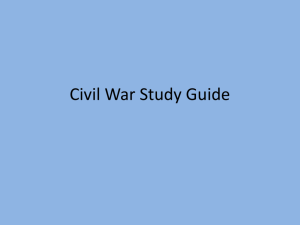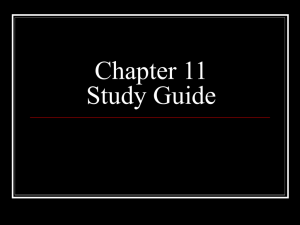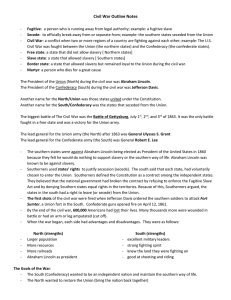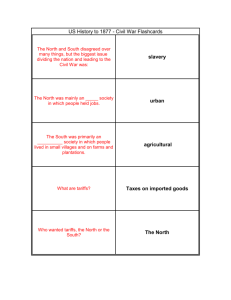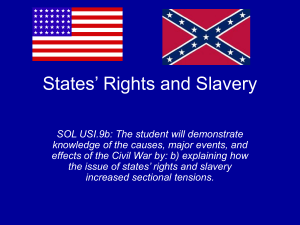US1.9 Question Answer Packet
advertisement
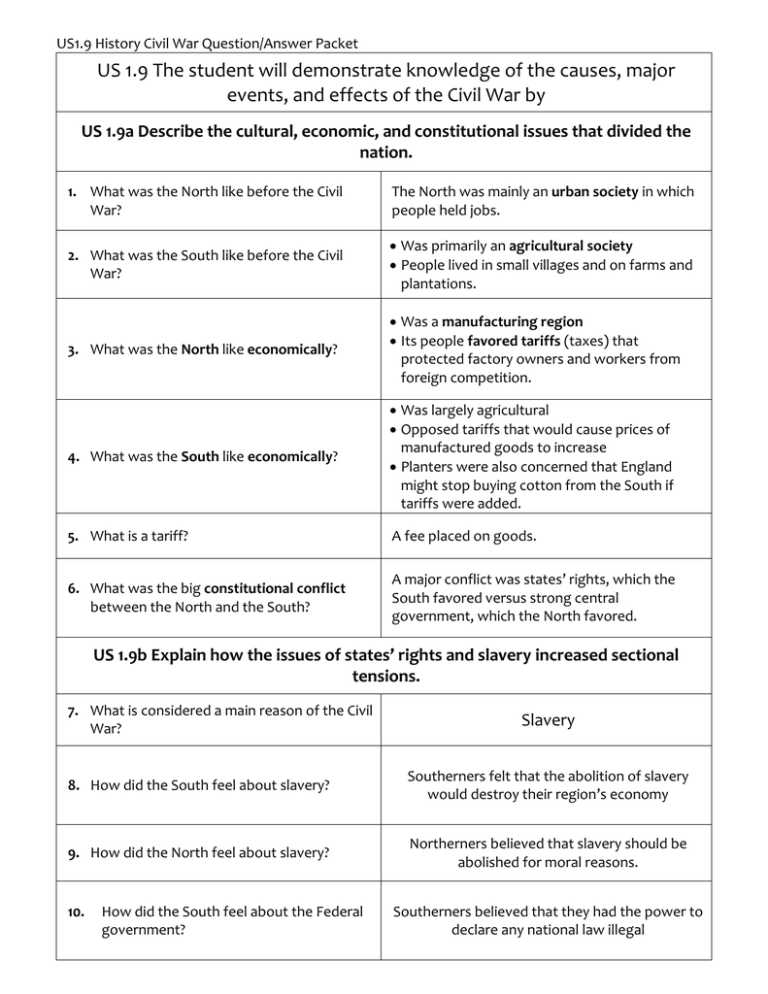
US1.9 History Civil War Question/Answer Packet US 1.9 The student will demonstrate knowledge of the causes, major events, and effects of the Civil War by US 1.9a Describe the cultural, economic, and constitutional issues that divided the nation. 1. What was the North like before the Civil War? The North was mainly an urban society in which people held jobs. 2. What was the South like before the Civil War? Was primarily an agricultural society People lived in small villages and on farms and plantations. 3. What was the North like economically? Was a manufacturing region Its people favored tariffs (taxes) that protected factory owners and workers from foreign competition. 4. What was the South like economically? Was largely agricultural Opposed tariffs that would cause prices of manufactured goods to increase Planters were also concerned that England might stop buying cotton from the South if tariffs were added. 5. What is a tariff? A fee placed on goods. 6. What was the big constitutional conflict between the North and the South? A major conflict was states’ rights, which the South favored versus strong central government, which the North favored. US 1.9b Explain how the issues of states’ rights and slavery increased sectional tensions. 7. What is considered a main reason of the Civil War? Slavery 8. How did the South feel about slavery? Southerners felt that the abolition of slavery would destroy their region’s economy 9. How did the North feel about slavery? Northerners believed that slavery should be abolished for moral reasons. 10. How did the South feel about the Federal government? Southerners believed that they had the power to declare any national law illegal Northerners believed that the national government’s power was supreme over that of the states 11. How did the North feel about the Federal government? 12. What were the four dividing issues between the North and the South that led to the Civil War? Slavery Economical Cultural Constitutional issues 13. What was the Missouri Compromise? Missouri entered the Union as a slave state; Maine entered the Union as a free state. 14. When did the Missouri Compromise occur? 1820 15. What was the Compromise of 1850? California entered the Union as a free state. Southwest territories would decide the slavery issue for themselves. 16. What was the Kansas-Nebraska Act? People in each state would decide the slavery issue (“popular sovereignty”). 17. What is popular sovereignty? 18. What is secession? 19. What happened to start the Civil War? 20. How did Lincoln and other Northerners feel about secession? 21. How did Southerners feel about secession? People make the decision by voting To leave being a part of a group Following Lincoln’s election, the southern states seceded from the Union. Confederate forces attacked Fort Sumter, in South Carolina, marking the beginning of the Civil War. Lincoln and many Northerners believed that the United States was one nation that could not be separated or divided. Most Southerners believed that states had freely created and joined the union and could freely leave it. US 1.9c Identify on a map the states that seceded from the Union and those that remained in the Union. 22. What states seceded from (left) the Union? 23. What states were Border States (slave states) that stayed in the Union? 24. What states were Free states? 1. Alabama 2. Arkansas 3. Florida 4. Georgia 5. Louisiana 6. Mississippi 1. Delaware 2. Kentucky 3. Maryland 4. Missouri 7. North Carolina 8. South Carolina 9. Tennessee 10. Texas 11. Virginia “Don’t 1. California 2. Connecticut 3. Illinois 4. Indiana 5. Iowa 6. Kansas 7. Maine 8. Massachusetts 9. Michigan 10. Minnesota Kick My Mule!” 11. New Hampshire 12. New Jersey 13. New York 14. Ohio 15. Oregon 16. Pennsylvania 17. Rhode Island 18. Vermont 19. Wisconsin 20. West Virginia (Western counties of Virginia that refused to secede from the Union) 25. What new state was formed at the beginning of the Civil War? West Virginia (Western counties of Virginia that refused to secede from the Union) US 1.9d Describe the roles of Abraham Lincoln, Jefferson Davis, Ulysses S. Grant, Robert E. Lee, Thomas “Stonewall” Jackson, and Frederick Douglass in events leading to and during the war. 26. What were some of Abraham Lincoln’s important ideas and events during his presidency? 27. Who was Jefferson Davis? President of the United States during the Civil War Opposed (against) the spread of slavery Issued the Emancipation Proclamation Determined to preserve the Union—by force if necessary Believed the United States was one nation, not a collection of independent states Wrote the Gettysburg Address that said the Civil War was to preserve a government “of the people, by the people, and for the people.” Was president of the Confederate States of America 28. Who was Ulysses S. Grant? 29. Who was Robert E. Lee? 30. Who was Thomas “Stonewall” Jackson? 31. Who was Frederick Douglas? He was the general of the Union army that defeated Lee Was leader of the Army of Northern Virginia Was offered command of the Union forces at the beginning of the war but chose not to fight against Virginia Opposed secession, but did not believe the union should be held together by force Urged Southerners to accept defeat at the end of the war and reunite as Americans when some wanted to fight on He was a skilled Confederate general from Virginia Was a former enslaved African American who escaped to the North and became an abolitionist US 1.9e Use maps to explain critical developments in the war, including major battles. 32. Where were the first shots of the Civil War fired? Fort Sumter, South Carolina 33. What was the first major battle of the Civil War? The first Battle of Manassas (Bull Run) was the first major battle. 34. What made freeing the slaves the new focus of the war? 35. What did the Battle of Vicksburg do? 36. What was the turning point of the war? 37. What happened to end the Civil War? 38. What were four major deciding factors in winning the Civil War? The signing of the Emancipation Proclamation made “freeing the slaves” the new focus of the war. Many freed slaves joined the Union army. The Battle of Vicksburg divided the South; the North controlled the Mississippi River. The Battle of Gettysburg was the turning point of the war; the North repelled Lee’s invasion. Lee’s surrender to Grant at Appomattox Court House in 1865 ended the war. 1. The Union blockade of southern ports (e.g., Savannah, Charleston, New Orleans) 2. Control of the Mississippi River (e.g., Vicksburg) 3. Battle locations influenced by the struggle to capture capital cities (e.g., Richmond; Washington, D.C.) 4. Control of the high ground (e.g., Gettysburg) US 1.9f Describe the effects of war from the perspective of Union and Confederate soldiers (including black soldiers), women, and enslaved African Americans. 39. What were some effects of the Civil War? 40. Who was Clara Barton? 41. How did the Civil War affect African Americans? 42. Who was Robert Smalls? Families and friends were often pitted against one another. Southern troops became increasingly younger & more poorly equipped and clothed. Much of the South was devastated at the end of the war (e.g., burning of Atlanta & Richmond). Disease was a major killer. Combat was brutal & often man-to-man. Women were left to run businesses in the North and farms & plantations in the South. The collapse of the Confederacy made Confederate money worthless Clara Barton, a Civil War nurse, created the American Red Cross. African Americans fought in both the Confederate and Union armies. The Confederacy often used enslaved African Americans as naval crew members and soldiers. The Union moved to enlist African American sailors early in the war. African American soldiers were paid less than white soldiers. African American soldiers were discriminated against and served in segregated units under the command of white officers. Robert Smalls was an African American He was a sailor and later a Union naval captain He was highly honored for his feats of bravery and heroism. He became a Congressman after the Civil War.
